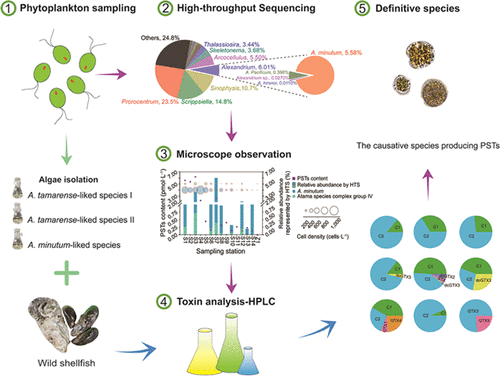当前位置:
X-MOL 学术
›
Environ. Sci. Technol.
›
论文详情
Our official English website, www.x-mol.net, welcomes your
feedback! (Note: you will need to create a separate account there.)
Identifying the Source Organisms Producing Paralytic Shellfish Toxins in a Subtropical Bay in the South China Sea
Environmental Science & Technology ( IF 10.8 ) Pub Date : 2021-02-10 , DOI: 10.1021/acs.est.0c06991 Yang Liu 1, 2 , Zhenfan Chen 3 , Yue Gao 4 , Jian Zou 5 , Songhui Lu 5 , Li Zhang 1, 2
Environmental Science & Technology ( IF 10.8 ) Pub Date : 2021-02-10 , DOI: 10.1021/acs.est.0c06991 Yang Liu 1, 2 , Zhenfan Chen 3 , Yue Gao 4 , Jian Zou 5 , Songhui Lu 5 , Li Zhang 1, 2
Affiliation

|
Identifying the exact phytoplanktonic sources of paralytic shellfish toxins (PSTs) is crucial for monitoring and preventing the buildup of toxin pollution, especially for causative species occurring at low levels. Phytoplankton and shellfish samples were simultaneously collected from representative mariculture zones in Daya Bay, China. Low concentration/low toxicity PSTs predominated with N-sulfocarbamoyl toxins 1, 2 (C1/2) being detected in phytoplankton (≤6.25 pmol L–1) and shellfish (≤0.21 μg STXeq g–1), which pose a potential risk of seafood poisoning. High-throughput sequencing of the phytoplankton samples based on 18S rDNA V4 regions identified 93 genera in 445 operational taxonomic units (OTUs). Five OTUs were assigned to Alexandrium hiranoi, Ambicodamus leei, Alexandrium pacificum, Alexandrium minutum, and an uncertain Alexandrium sp. A. pacificum and A. minutum are candidate PST producers and observed under the light microscope with densities of 66–972 cells L–1. Three strains of toxigenic species were successfully isolated and identified as A. pacificum and A. minutum based on their 18S rDNA V4 regions. The predominant toxins in A. pacificum were C1/2 (43.9–53.6 fmol cell–1) and resembled the toxins found in field samples predominated with C1/2. A. minutum produced only gonyautoxins 2/3 (8.03 fmol cell–1). Therefore, A. pacificum was identified as the predominant PST contributor in this area. This research makes a valuable contribution to the understanding of the traceability of phycotoxins in marine waters.
更新日期:2021-03-02











































 京公网安备 11010802027423号
京公网安备 11010802027423号